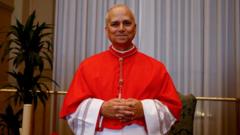As the Vatican conclave continues, black smoke has emerged from the Sistine Chapel, indicating that no pope has been elected on the second day of voting. This conclave is characterized by deep divisions among the cardinals over issues of inclusion and tradition, mirroring the legacy of the recently deceased Pope Francis.
Vatican Conclave Remains Deadlocked as Black Smoke Signals Ongoing Voting

Vatican Conclave Remains Deadlocked as Black Smoke Signals Ongoing Voting
The Vatican's conclave enters its second day with no consensus on a new pope as the cardinals grapple with internal divisions and the legacy of Pope Francis.
In the high-stakes atmosphere of the Vatican, day two of the conclave reportedly began with black smoke billowing from the Sistine Chapel's chimney, a clear sign that the 133 participating cardinals have not reached the requisite two-thirds majority needed to elect a new pope. The lengthy first ballot, which lasted over three hours, raised questions regarding internal complexities and diverse political dynamics among the freshly assembled cardinal body, primarily appointed by the late Pope Francis.
As spectators crowded in St. Peter’s Square awaiting results of the cardinal assembly, discussions arose around the reasons behind the slow voting process. Conclave behaviors are currently shaped by the necessity for a consensus, reflecting the stark contrasts between progressive and conservative factions within the church. These differences pose significant potential for delay in reaching a decision, as cardinals devote hours to deliberation under strict rules of secrecy, devoid of any outside communication.
Historically, the conclave allows up to four rounds of voting each day, with resolutions indicated by the smoke signals produced from burning the ballots. The practice remains rooted in tradition; lessons from previous conclaves showcase a range of election durations, from mere hours to stretches exceeding two years. Cardinal Timothy M. Dolan of New York underscored this unpredictability, suggesting planning for a longer conclave, given the relatively unfamiliar dynamics among many of the cardinals.
The ongoing lack of agreement signals that critical decision-making lies ahead, where the outcome may pivot on whether the new leader continues along the inclusivity-oriented path of Francis or aligns more closely with conservative traditions. As anticipation mounts, the implications of the conclave extend far beyond the church, ultimately impacting 1.4 billion followers globally, reflecting on fundamental matters of doctrine and direction for the Catholic Church moving forward.
As spectators crowded in St. Peter’s Square awaiting results of the cardinal assembly, discussions arose around the reasons behind the slow voting process. Conclave behaviors are currently shaped by the necessity for a consensus, reflecting the stark contrasts between progressive and conservative factions within the church. These differences pose significant potential for delay in reaching a decision, as cardinals devote hours to deliberation under strict rules of secrecy, devoid of any outside communication.
Historically, the conclave allows up to four rounds of voting each day, with resolutions indicated by the smoke signals produced from burning the ballots. The practice remains rooted in tradition; lessons from previous conclaves showcase a range of election durations, from mere hours to stretches exceeding two years. Cardinal Timothy M. Dolan of New York underscored this unpredictability, suggesting planning for a longer conclave, given the relatively unfamiliar dynamics among many of the cardinals.
The ongoing lack of agreement signals that critical decision-making lies ahead, where the outcome may pivot on whether the new leader continues along the inclusivity-oriented path of Francis or aligns more closely with conservative traditions. As anticipation mounts, the implications of the conclave extend far beyond the church, ultimately impacting 1.4 billion followers globally, reflecting on fundamental matters of doctrine and direction for the Catholic Church moving forward.






















